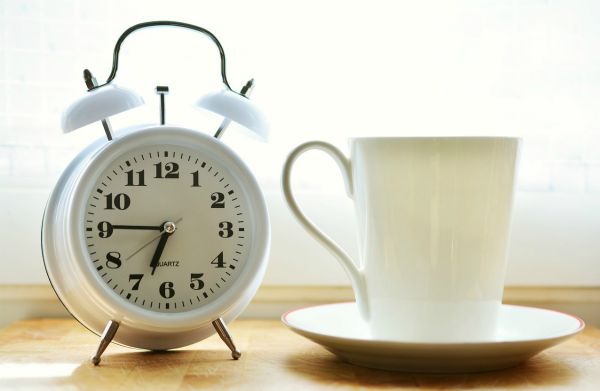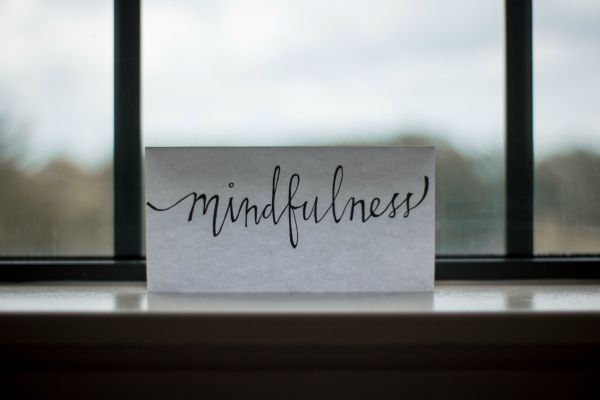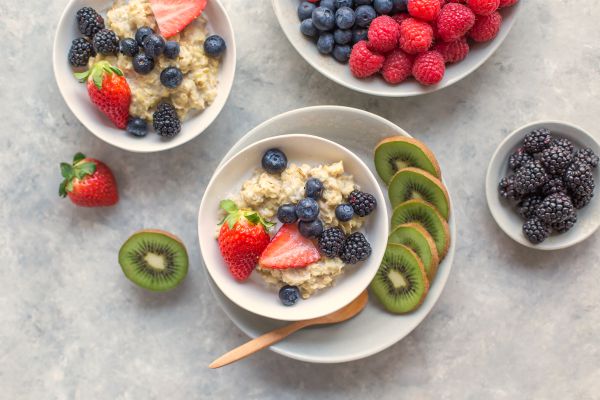A healthy morning routine is a powerful thing. It can energize and empower you. It can kickstart a positive and productive day. It can even foster a long-overdue peace treaty between you and your alarm clock.
In short, it’s a better way to start your day.
Now, if you’re wondering what a healthy morning routine actually looks like, wonder no more. To help you build healthy habits for 2019, we’ve laid out a specific template you can follow. It’s science-backed (because we’re all about the science) and specific (because we want to make life easy for you)—but it’s also adaptable to your needs. Bonus? The whole routine, start to finish, only adds about an hour onto your morning. And trust us, this is the power hour redefined.
A Healthy Morning Routine For Better Days This Year
So let’s get into it: Here’s a healthy morning routine you can use to get the best out of 2019.
First thing’s first: Wake up earlier

Reality check: A healthy morning routine takes time. That means you’ll probably have to wake up a bit earlier. But trust us, it doesn’t mean that you’ll have to survive on less sleep. Instead, work with your body’s circadian rhythms by adjusting both your sleep and wake-up times simultaneously.
What’s the best way to do that? In increments, of course, says Stephanie Silberman, PhD, sleep specialist and author of The Insomnia Workbook, in an article on Psych Central. Start by both going to bed and waking up 15 minutes earlier than usual. Once you adjust to this new pattern (it’ll probably take three to four days—the exact amount of time varies by person), move your schedule by 15 minutes earlier again. Keep doing this in 15-minute increments until you nail the wake-up time you want.
Immediately after waking: Stretch your body (2 minutes)

It’s totally normal to wake up feeling kind of like a zombie. In our opinion, that’s good news because it means we’re not alone in our groggy state of being. But there are some easy ways to ease into wakefulness, and here’s one of them: Just stretch your body.
We’re not saying you should crack out some Zen-like sun salutations—in fact, don’t even get out of bed. Just do that yawny thing where you throw your arms up and stretch out your legs to shake off the stiffness of sleep.
There’s a reason this feels so good. Explains science writer, Luis Villazon, for BBC Focus Magazine: “When you sleep, your muscles lose tone and fluid tends to pool along your back. Stretching helps to massage fluid gently back into the normal position.”
On top of that, Harvard psychologist, Amy Cuddy, argues that stretching your body as widely as possible is a kind of “power pose.” According to Cuddy, doing such a stretch before you get out of bed can already set you up to feel more confident for the day.
So uncurl yourself from your sleepy ball and reach for the stars (or, erm, the ceiling).
10 minutes after waking: Meditate (10 minutes)

Now you’ve spent a few minutes stretching your body back to life. The next step in your healthy morning routine is about preparing your mind for the day ahead. Our suggestion: A short meditation practice.
Find somewhere quiet and comfortable. And no, lying under the covers with your eyes closed “meditating” (aka, snoozing) doesn’t count. Why meditate? There are countless studies that prove the benefits. Shawn Achor sums it up neatly in his book, The Happiness Advantage:
Studies show that in the minutes right after meditating, we experience feelings of calm and contentment, as well as heightened awareness and empathy. And, research even shows that regular meditation can permanently rewire the brain to raise levels of happiness, lower stress, even improve immune function.”
So meditation = good. Regular meditation = better. As for what type to do? There’s no right or wrong. Try:
- Loving-kindness meditation for boosting feelings of compassion, reducing negative emotions, and reducing depression and anxiety. Here’s a guided loving-kindness meditation you can try right now.
- Mindfulness meditation for becoming more present. A mindfulness meditation can be as simple as paying attention to your breath or how your body feels.
- A meditation app for trying out different guided meditations. This is an especially great option if you’re a beginner. Here are some of the best meditation apps out there.
Need some more guidance? Try these tips:
- If 10 minutes is too long, start out with five and work your way up.
- Don’t worry if your mind wanders. Simply observing the fact your mind is taking off and doing your best to reign it in (even if you fail) is a form of mindfulness.
- As you get more advanced, increase the length of your sessions.
20 minutes after waking: Exercise (15 minutes)

You’re in the headspace now. Since the body and mind are deeply connected, why not use that focused state to get some physical activity in for the day?
Exercising in the morning has its advantages.
- Training first thing before eating (aka in a fasted state) has health benefits, suggests research—like counterbalancing a high-fat diet by improving glucose tolerance and insulin sensitivity.
- A small 2017 study found that morning exercise was more effective at controlling how much you eat.
- According to the National Sleep Foundation, working out in the morning even leads to deeper sleep at night.
So what type of exercise to do?
For maximum gains in minimum time: 10 minutes HIIT (+five-minute warmup)

HIIT involves short bursts of pushing yourself as hard as you can go. The purpose? Maximum gains in minimum time.
There are so many different HIIT routines and programs out there, ranging from four-minute “Tabata” workouts to longer HIIT sessions. And the exercises can involve anything from sprinting to cycling to bodyweight movements.
Recent research from Les Mills Academy suggests that you don’t want to spend more than 30–40 minutes per week with your heart rate above 90 percent, or you’ll end up overtraining. For this healthy morning routine, we’re therefore suggesting roughly five minutes of warmup (e.g., jumping rope or walking) followed by about 10 minutes of HIIT.
Given you won’t be in the 90 percent heart rate range the for the whole 10 minutes, it’s unlikely that you’ll go over the recommended weekly limit.
Try these tips:
- Mix it up. Keep your HIIT challenging by changing up your routines regularly.
- Not sure how to build a HIIT workout? A good option is to try a fitness app that offers a variety of plans.
- Prep your workout gear the night before to make your healthy morning routine easier to follow (and excuses harder to make).
For a low-impact alternative: 15 minutes walking

We get that not everyone can go from bed to smashing out burpees. If your health situation requires a calmer alternative, a walk is an excellent way to start the day.
Fifteen minutes might not seem long enough to dramatically impact your fitness levels, but you’d be surprised by the benefits even a short walk can bring.
- One study found that a 15-minute walk led participants to eat half as much chocolate as those who didn’t walk. (So long, sugar cravings!)
- Another study found that just 15 minutes of walking per day led to a 22 percent lower risk of death in older adults.
- And of course, walking invigorates you, gets your blood flowing, and, if done outside, gets you that little burst of fresh air and vitamin D.
Try these tips:
- Take your walk in nature for even better results. Walking in nature may improve focus and reduce stress.
- To make your walk more mindful, focus positively on what’s around you. Research shows that savoring our surroundings as we walk leads to increased happiness.
40 minutes after waking: Set your goals for the day (10 minutes)

Take five minutes to cool down after your workout and then settle down at a comfy desk to ponder on the day ahead. The big question? What do you want to achieve today?
Don’t just think about it though. Write your goals down. Research from Dominican University found that “those who wrote their goals accomplished significantly more than those who did not write their goals.” Setting goals for the day can also get your thoughts out of your head and into an organized plan. Conveniently enough, that’s also a science-backed way to free up cognitive resources and allow you to focus your attention on the right stuff.
Consider using a paper-based planner: Not only does it feel more tangible, but that way you can access your schedule, goals, daily plans, and other notes all in the one place. It also means you can stay off your devices (and avoid getting sidetracked by emails and social media).
Try these tips:
- Remember to make your goals SMART: specific, measurable, attainable, relevant, and time-bound.
- Not sure how to structure your daily plans on paper? Get yourself a Panda Planner. Panda Planner is designed on scientific research, so it’ll make the process of tracking your goals, priorities, plans, and habits super-simple and effective.
50 minutes after waking: Fuel up (10 minutes)

We’d hardly pack you up and send you off to start your day without making time to fill that belly. After all, a healthy breakfast is an important part of most people’s healthy morning routine.
Even if you’re not a breakfast eater (intermittent fasting is a thing, we know), you might still like to spend 10 minutes indulging in a morning cup of coffee. Research tends to support a moderate amount of caffeine as a pleasant way to boost to your energy levels and mood.
To sum it all up…

You might not think you could ever be one of those people—the ones who’ve already meditated, worked out, set goals, and downed a green super smoothie before the rest of us have even opened our eyes. But it can be done. In an hour, at that. Welcome to the new you.
All that said, the above healthy morning routine is intended to be experimented with, adjusted, and added to. As it is, it provides a research-backed set of activities that will help you face the day feeling energized, focused, and accomplished. Tweak the time accordingly, and it can become an even more powerful personal routine that’s purpose-built just for you.
A few things to keep in mind:
- Be consistent. Your best bet is to keep your wake up time consistent all the time (yes, even weekends) so you don’t break your body’s rhythm.
- You don’t have to dramatically change your entire lifestyle overnight. You can build your routine by adding or changing one thing at a time.
- Remember your why. Keep the benefits of your healthy morning routine in mind so you stay motivated, especially at the start. As the routine starts to pay off, the positive impacts will propel you to keep it going.
Your turn: What does your healthy morning routine look like? And how might it look even better? Share in the comments.

Author: Tania Braukamper
Tania Braukamper is an Australian-born writer and photographer. She believes in curiosity, kindness, and adventure as a state of mind.

 Justin says
Justin says
December 19, 2018 at 11:23 amThis is basically a condensed version of Hal Elrod’s Miracle Morning.
 Arnab Chakrabarty says
Arnab Chakrabarty says
December 20, 2018 at 9:40 amGreat tips. I do feel one can add drinking good amount of water and Journal writing as part of the ritual. And the rest depends on consistency and coming back after being inconsistent for whatever reasons.
 Chelsey Taylor says
Chelsey Taylor says
December 20, 2018 at 9:45 amThanks so much, Arnab! We agree that staying hydrated and reflecting on your day, progress, and internal dialogue can be helpful steps in a morning routine. And, of course, the hardest part about a morning routine is making it habitual. None of us are perfect, so we just do the best we can. Thanks again!
 Tami says
Tami says
February 21, 2019 at 1:44 pmI love this routine, however, that’s a lot of time between waking up and getting in the shower and getting dressed, hair done, make up, etc. assuming you follow the time line. Do we squeeze that into the routine somewhere or do it after breakfast?
 Sarah Lopes says
Sarah Lopes says
February 26, 2019 at 3:16 pmGreat question! This is a great pre-shower routine. If you already have a morning routine, you can do is start by adding just one element from this routine into your existing one. You can also mix and match where it fits in! For example, maybe you set your daily goals while eating your breakfast or right after. We’d love to know what elements from this routine you add into yours!
 Jeff says
Jeff says
March 2, 2019 at 1:07 pmSounds great for the most part. I’ll just substitute prayer for meditationm
 Chelsey Taylor says
Chelsey Taylor says
March 4, 2019 at 4:35 pmThanks for the comment, Jeff! That’s a good substitution, and we’re glad you have something that works for you. Thanks again!
 James says
James says
April 17, 2019 at 1:54 pmI recently added sit ups to my morning push ups. Other than that, I can’t really say that I have a morning routine.
 Chelsey Taylor says
Chelsey Taylor says
April 17, 2019 at 4:35 pmThanks, James. That sounds like a routine to us! If it works for you, that’s great. If you’re up for it, add one of these tips and see how it affects your early hours. Thanks again!
 Sara says
Sara says
April 21, 2019 at 2:37 amCool but um I already do like half of that stuff but it’s good for oversleepers and people who aren’t morning people
 Chelsey Taylor says
Chelsey Taylor says
April 23, 2019 at 11:06 amThanks for the comment, Sara! Perhaps some of our other morning routine content would have some new ideas for you. Try this post: https://positiveroutines.com/great-morning-tips/